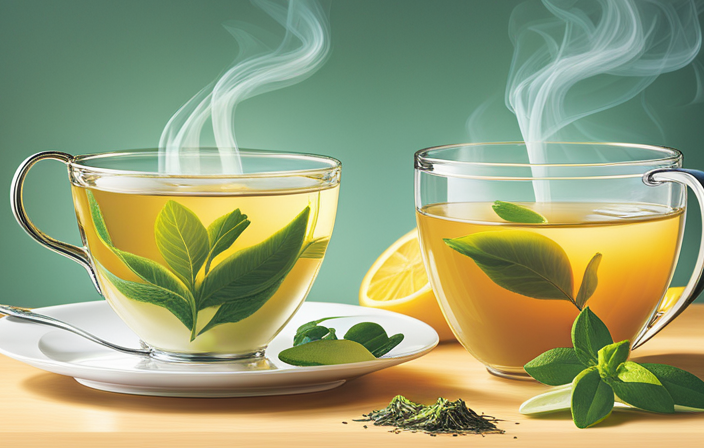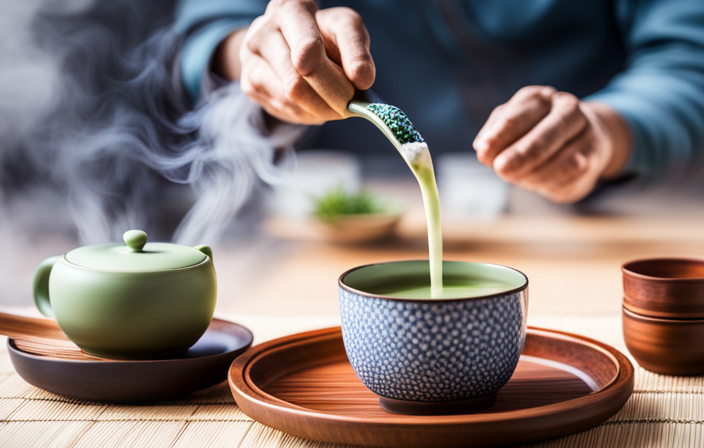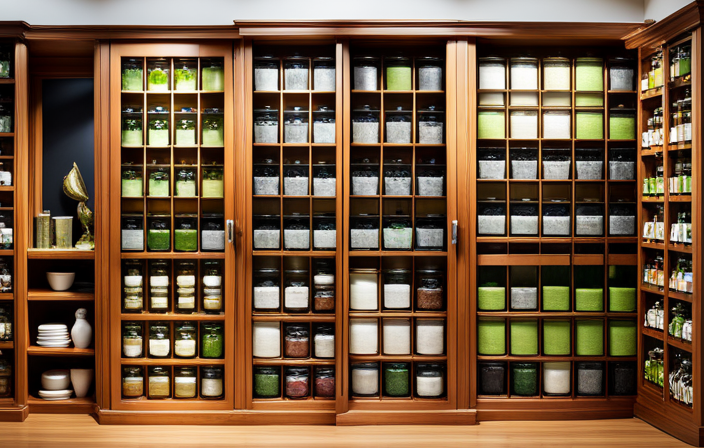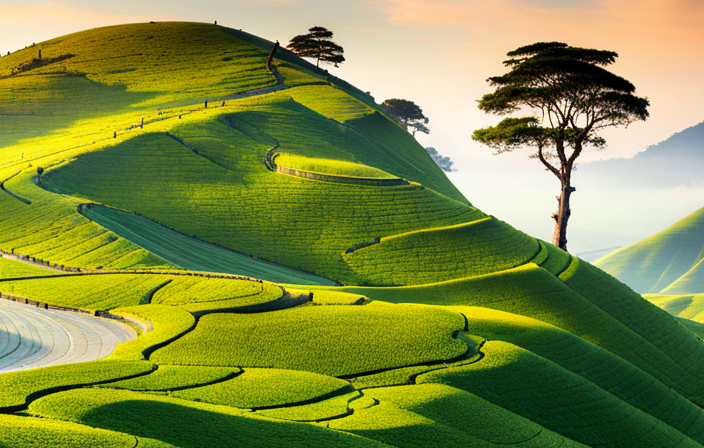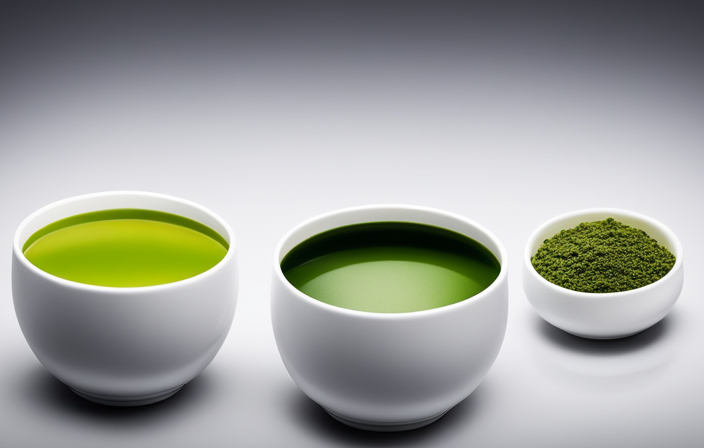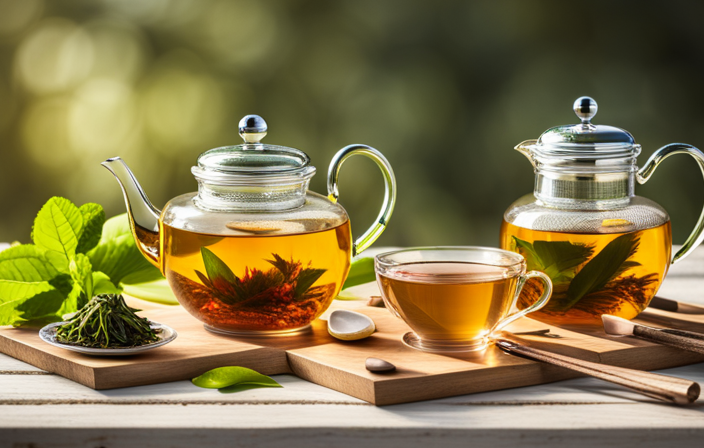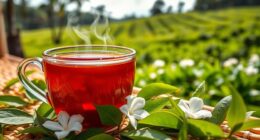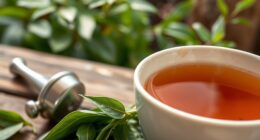I have always been curious as a tea lover, why does green tea sometimes taste bitter?
After conducting extensive research, I’ve discovered several key factors that contribute to this unique flavor.
From the duration of steeping to the quality and freshness of the leaves, each element plays a role in the bitterness of green tea.
In this article, I will delve into these factors and share some tips to enhance the flavor of your green tea experience.
So grab a cup and let’s explore together!
Key Takeaways
- Steeping time: Longer steeping time increases bitterness, so it is important to follow the recommended steeping duration provided by the tea manufacturer.
- Water temperature: Too hot water leads to a bitter taste, while too cool water results in a weak and lackluster taste. Finding the optimal water temperature between 175 to 185 degrees Fahrenheit is key to avoiding bitterness.
- Quantity and quality of tea leaves: Using excessive amounts of tea leaves can lead to bitterness, so it is important to follow the recommended tea-to-water ratio. Higher quality leaves tend to have a smoother and less bitter taste.
- Freshness of tea leaves: Stale tea leaves result in a dull and bitter brew, while freshly harvested tea leaves retain their natural flavors and delicate characteristics. Choosing green tea made from fresh leaves ensures the best quality and taste.
Steeping Duration and Bitterness
I’ve noticed that the longer I steep my green tea, the stronger the bitterness becomes. The steeping technique and brewing equipment play a crucial role in determining the taste of your green tea. To achieve a perfectly balanced cup, it’s important to understand the optimal steeping duration and select the right brewing equipment.
When steeping green tea, it’s recommended to follow the instructions provided by the tea manufacturer. Typically, green tea requires a shorter steeping time compared to other types of tea. Oversteeping can lead to excessive bitterness. To avoid this, set a timer and remove the tea leaves or tea bag promptly after the recommended time.
The type of brewing equipment you use also affects the taste. For example, using a teapot with a built-in infuser allows the tea leaves to expand and release their flavors more effectively. This ensures a better extraction and minimizes the risk of bitterness caused by oversteeping.
Impact of Water Temperature on Green Tea Taste
When it comes to brewing green tea, the water temperature plays a crucial role in determining its taste. The optimal water temperature for brewing green tea is typically around 175 to 185 degrees Fahrenheit.
If the water is too hot, it can lead to a bitter and astringent taste, overpowering the delicate flavors of the tea leaves.
However, if the water is too cool, the tea may end up tasting weak and lackluster.
Finding the perfect balance in water temperature is key to achieving a well-balanced and enjoyable cup of green tea.
Optimal Water Temperature
The optimal water temperature for brewing green tea is 175 degrees Fahrenheit. This temperature ensures that the tea leaves release their flavors without becoming bitter. When the water is too hot, it can scorch the leaves and result in a bitter taste. On the other hand, if the water is too cool, the tea won’t steep properly and the flavors will be weak. To emphasize the importance of water temperature, I have created a table below that outlines the optimal brewing techniques for green tea:
| Water Temperature | Steeping Time | Resulting Flavor |
|---|---|---|
| 175°F | 2 minutes | Balanced |
| 160°F | 3 minutes | Subtle |
| 185°F | 1 minute | Strong |
Bitterness Due to Overheating
Experiencing bitterness due to overheating is frustrating, but by adjusting the water temperature and using proper brewing techniques, you can avoid this issue and enjoy a perfectly balanced cup of green tea.
Overheating prevention is crucial in preserving the delicate flavors of green tea. When water is too hot, it can scorch the leaves and release unwanted bitter compounds. To prevent overheating, it’s recommended to use water that’s around 175°F (80°C) for green tea. This temperature allows the tea leaves to steep gently, preserving their natural flavors and preventing bitterness.
It’s also important to pay attention to the steeping time, as leaving the tea leaves in hot water for too long can also result in a bitter taste.
Transitioning into the next section, another factor that can contribute to bitterness is the quantity of tea leaves used.
Quantity of Tea Leaves Used and Bitterness
I can taste the bitterness when I use too many tea leaves. The quantity of tea leaves used in brewing green tea can greatly impact its flavor. When we use an excessive amount of leaves, the resulting brew becomes overpoweringly bitter. To avoid this, it’s important to follow the recommended guidelines for tea-to-water ratio.
Generally, a teaspoon of green tea leaves per cup of water is a good starting point. However, personal preferences may vary, so feel free to adjust accordingly. Additionally, brewing methods can also affect the bitterness of green tea. Steeping the leaves for too long or using water that’s too hot can extract more tannins and lead to a bitter taste.
Lastly, it’s worth noting that additives like sugar or milk can also influence the flavor profile of green tea. While they may help balance the bitterness, they can alter the tea’s natural taste. Therefore, it’s best to explore different brewing techniques and find the perfect balance to enjoy a delightful cup of green tea.
Quality of Tea Leaves and Bitterness
When it comes to the bitterness of green tea, the quality of the tea leaves plays a significant role. Higher quality leaves tend to have a smoother and less bitter taste compared to lower quality leaves. This is because the processing methods used for high quality leaves are more meticulous, resulting in a tea with a more delicate and balanced flavor.
Additionally, the freshness of the leaves can also affect the bitterness, as older leaves are more likely to develop a bitter taste.
Leaf Oxidation and Bitterness
Although leaf oxidation plays a significant role in the bitterness of tea, other factors such as steeping time and water temperature also contribute to the overall taste.
When it comes to leaf quality, the freshness and processing of the leaves can greatly affect the bitterness. Fresher leaves tend to have a milder taste, while older leaves may be more bitter.
Additionally, the brewing technique used can impact the bitterness of the tea. Steeping the leaves for too long or using water that’s too hot can result in a more bitter taste. On the other hand, steeping for a shorter period and using cooler water can help reduce the bitterness.
Brewing Temperature and Bitterness
To achieve the perfect balance of flavors in my green tea, I must carefully consider the brewing temperature and the quality of the tea leaves. Optimal brewing involves temperature control, as different temperatures can significantly affect the taste profile of green tea. Green tea is best brewed at a lower temperature, around 175°F (80°C), to avoid extracting excessive bitterness from the leaves. This temperature allows the delicate flavors to unfold, resulting in a smoother and more enjoyable cup. However, it’s essential to note that different types of green tea may require slight temperature adjustments. By controlling the brewing temperature, I can ensure that my green tea retains its delicate flavors while minimizing any potential bitterness.
Now, let’s move on to the next consideration: steeping time and its impact on bitterness.
Steeping Time and Bitterness
I find that a shorter steeping time of one minute results in a less bitter cup of green tea. When it comes to brewing green tea, managing the steeping time is crucial in achieving the desired flavor profile.
Here are some key points to consider for steeping time management and reducing bitterness:
-
The longer the tea leaves steep, the more bitter the flavor becomes. Shortening the steeping time can help to minimize bitterness.
-
Green tea leaves are delicate and can easily become over-steeped, resulting in a bitter taste. It’s important to monitor the steeping time closely to avoid this.
-
Experimenting with different steeping times can help you find the perfect balance between flavor and bitterness. Start with a shorter steeping time and gradually increase if desired.
Freshness of Tea Leaves and Its Influence on Taste
I’ve noticed that the taste of my green tea is significantly affected by the freshness of the tea leaves. The influence of storage and the impact of processing play a crucial role in determining the quality and flavor of green tea.
When tea leaves are stored for a long time, they can become stale, losing their vibrant taste and aroma. This can result in a dull and bitter brew.
On the other hand, freshly harvested tea leaves undergo minimal processing, allowing them to retain their natural flavors and delicate characteristics. These leaves are rich in antioxidants and have a smoother, more pleasant taste.
To ensure the best quality, it’s important to choose green tea made from fresh leaves and store it properly to maintain its freshness. By doing so, you can enjoy a truly delightful cup of green tea every time.
Other Factors Affecting the Bitterness of Green Tea
The steeping time of green tea can greatly affect its bitterness. When steeped for too long, the tea leaves release more tannins, which contribute to a bitter taste. On the other hand, steeping for too short a time may result in a weak and bland flavor.
In addition to steeping time, there are other factors that can affect the bitterness of green tea:
-
Leaf quality: The quality of the tea leaves used can greatly impact the taste of the brewed tea. Higher quality leaves tend to have a smoother and less bitter flavor compared to lower quality leaves.
-
Water temperature: Brewing green tea at a high temperature can extract more bitterness from the leaves. It’s recommended to use water that’s around 175°F (80°C) to prevent excessive bitterness.
-
Flavor enhancement techniques: Some people add a touch of sweetness, such as honey or sugar, to balance out the bitterness of green tea. Others may experiment with different flavorings, such as lemon or mint, to enhance the overall taste.
Tips to Enhance the Flavor of Green Tea
Adding a squeeze of fresh lemon to my green tea enhances the flavor and gives it a refreshing twist.
But what’re some other ways to reduce the bitterness of green tea and make it more enjoyable?
One effective method is to adjust the brewing time and water temperature. Steeping green tea for a shorter duration, around 1-2 minutes, can help reduce bitterness. Similarly, using slightly cooler water, around 170-180°F (77-82°C), instead of boiling water, can also result in a smoother, less bitter taste.
Additionally, flavor pairing suggestions can help balance the bitterness of green tea. Adding a teaspoon of honey or a splash of milk can add sweetness and creaminess, counteracting the bitterness. Another option is to infuse the tea with fresh fruits like berries or citrus slices, which can add a natural sweetness and complement the green tea flavor.
Frequently Asked Questions
What Is the Ideal Steeping Duration for Green Tea to Avoid Bitterness?
The ideal steeping duration for green tea to avoid bitterness is around 2-3 minutes. By following proper steeping techniques, such as using water at the right temperature and not over-brewing, you can achieve a smoother flavor.
How Does Water Temperature Affect the Taste of Green Tea?
Water temperature plays a crucial role in the taste of green tea. Different temperatures can bring out different flavors and intensities. It’s important to find the right balance to avoid bitterness and enhance the tea’s natural qualities.
Does the Quantity of Tea Leaves Used Affect the Bitterness of Green Tea?
Using the ideal steeping techniques and different brewing methods, I can confidently say that the quantity of tea leaves used does contribute to the sometimes bitter taste of green tea.
How Does the Quality of Tea Leaves Contribute to the Bitterness of Green Tea?
The quality of tea leaves can greatly impact the bitterness of green tea. Factors like the ideal water temperature and steeping time play a crucial role in extracting the flavors from the leaves without releasing excessive bitterness.
How Does the Freshness of Tea Leaves Influence the Taste of Green Tea?
Freshness impact on green tea flavor profile is significant. For example, when leaves are harvested too late, they become bitter. The longer they sit, the more bitter the tea tastes.
Conclusion
In conclusion, the bitterness of green tea can be influenced by several factors.
Steeping duration, water temperature, quantity of tea leaves, quality and freshness of the leaves all play a role in determining the taste.
To enhance the flavor of green tea, it’s important to pay attention to these factors and adjust them accordingly.
By doing so, one can enjoy a more balanced and enjoyable cup of green tea.

